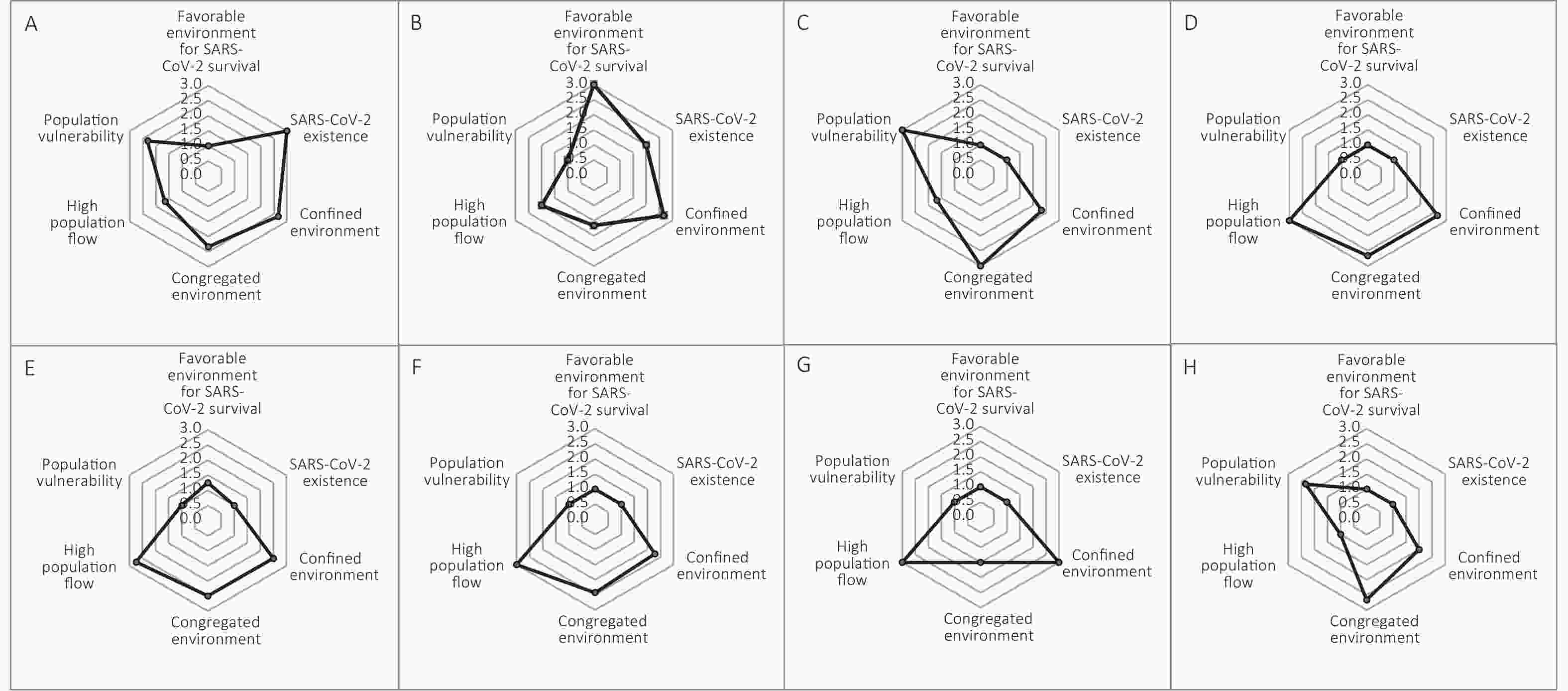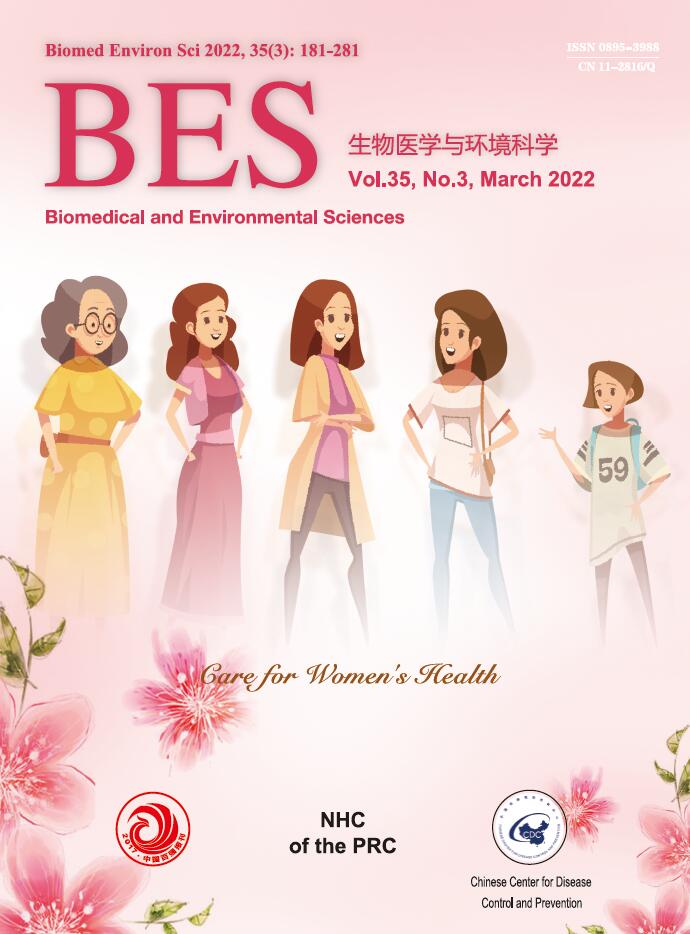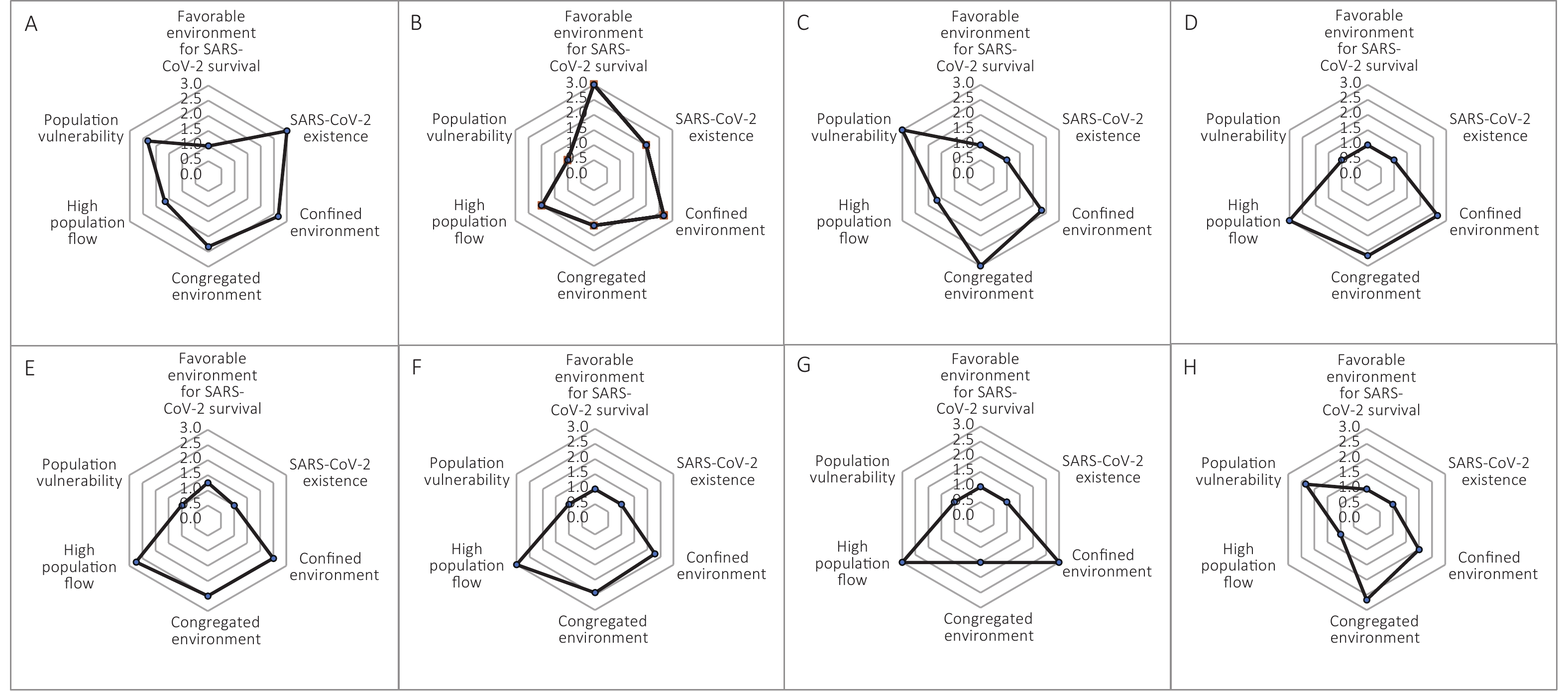-
The main transmission routes of Coronavirus Disease 2019 (COVID-19) include droplet and contact transmission. Airborne transmission may be possible in specific circumstances and settings in which aerosol-generating procedures are performed[1]. In 2020, more than 83.4 million confirmed cases of COVID-19, including more than 1.8 million deaths, were reported; in contrast, the numbers of cumulative confirmed cases and deaths in China were only 96,673 and 4,788, respectively[2]. Low temperatures might favor the spread of the disease in some countries and regions[3]. In France, the United Kingdom, Turkey, Italy, Spain, and Germany, COVID-19 spread was inhibited during the summer season, but the sudden increase after October implied that the pandemic rebounded in these areas. In addition, New Year’s day, Christmas day, and the Spring Festival in winter are associated with mass gatherings and frequent social activities, such as parliamentary meetings, receptions, and commemorative activities. These gatherings and activities in public places and workplaces can increase the risk of infection with the causative agent of COVID-19, SARS-CoV-2[4]; therefore, more rigorous precautions may be necessary. However, among women and parents, psychological reactions, stress, and overall emotional reactions have been reported to increase with age[5]. Thus, risk-based precautions in public places and workplaces must be focused on to maintain uninterrupted businesses operation, and to limit economic losses and adverse mental effects.
Because of high population density and personal mobility, and abundant contact opportunities, public places and workplaces favor the spread of COVID-19, because of the strong contagiousness and persistence of SARS-CoV-2. To develop a risk-based prevention and control strategy, public places and workplaces reported to be vulnerable to COVID-19 were classified into eight categories according to the Chinese national standards of the Regulations on the Administration of Public Health in Public Places: healthcare facilities and waste services; cold-chain food facilities; long-term care or detention facilities; catering and accommodation facilities; transport vehicles and stations; sports, culture, and entertainment venues; facilities providing essential services; and education places and workspaces (Supplementary Table S1, available in www.besjournal.com). The risk of SARS-CoV-2 infection in each location was evaluated according to the environmental perspectives of viral survival favorability, the existence of the virus (or confirmed cases), population confinement, population congregation, high population flow, and population vulnerability. According to the Delphi method, values of 1, 2, and 3 indicated low risk, moderate risk, and high risk of SARS-CoV-2 infection, respectively. The SARS-CoV-2 infection risk in eight categories of public places and workplaces are shown in Figure 1.

Figure 1. SARS-CoV-2 infection risk (0.0–3.0) in eight categories of public places and workplaces: healthcare facilities and waste services (A), cold-chain food facilities (B), long-term care and detention facilities (C), catering and accommodation facilities (D), transport vehicles and stations (E), sports, culture, and entertainment venues (F), facilities providing essential services (G), and education places and workspace (H).
No. Types Risk score Places Favorable environment for SARS-CoV-2 survival SARS-CoV-2 existence Confined environment Congregated environment High population flow Population vulnerability 1 Healthcare facilities and waste services 13.00 Hospitals $\otimes $ ● ● ● ● ● Centralized quarantine/isolation places $\otimes $ ● ● ● $\otimes $ ● Medical waste treatment plants $\otimes $ ● 
$\otimes $ $\otimes $ $\otimes $ 2 Places involved cold-chain food 12.34 Supermarkets and retail stores ● $\otimes $ ● ● ● $\otimes $ Meat/seafood manufacturing plants ● 

$\otimes $ $\otimes $ $\otimes $ Cold storage warehouses ● ● ● $\otimes $ 
$\otimes $ 3 Long term care and detention places 12.00 Nursing homes $\otimes $ $\otimes $ 
● 
● Orphanages $\otimes $ $\otimes $ 
● 
● Prisons $\otimes $ $\otimes $ ● ● $\otimes $ ● 4 Catering and accommodation places 11.33 Restaurants and coffee shops $\otimes $ $\otimes $ ● ● ● $\otimes $ Hotels $\otimes $ $\otimes $ 

● $\otimes $ Bars and nightclubs $\otimes $ $\otimes $ ● ● ● $\otimes $ 5 Transportation vehicles and stations 11.00 Airports, train stations, and intercity bus stations $\otimes $ $\otimes $ ● ● ● $\otimes $ Subway stations $\otimes $ $\otimes $ ● ● ● $\otimes $ Cruise 
$\otimes $ ● ● 
$\otimes $ Bus stations $\otimes $ $\otimes $ $\otimes $ $\otimes $ ● $\otimes $ 6 Sports, culture and entertainment places 10.71 Shopping malls $\otimes $ $\otimes $ ● ● ● $\otimes $ Large venues (casinos, theatre, cinema, sporty venues, etc.) $\otimes $ $\otimes $ ● ● ● $\otimes $ Gyms and fitness centers $\otimes $ $\otimes $ ● 
● $\otimes $ Museums, library, gallery, and exhibitions $\otimes $ $\otimes $ ● 
● $\otimes $ Places of worships $\otimes $ $\otimes $ 
● ● $\otimes $ Flea markets and fairs $\otimes $ $\otimes $ $\otimes $ ● ● $\otimes $ Parks, play grounds, and tourism sites $\otimes $ $\otimes $ $\otimes $ $\otimes $ ● $\otimes $ 7 Daily life service places 10.50 Hair salons and beauty salons $\otimes $ $\otimes $ ● 
● $\otimes $ Banks $\otimes $ $\otimes $ ● $\otimes $ ● $\otimes $ 8 Education places and workspace 10.00 Kindergarten $\otimes $ $\otimes $ 
● $\otimes $ ● Primary schools, middle schools, and universities $\otimes $ $\otimes $ 
● $\otimes $ ● Offices $\otimes $ $\otimes $ 

$\otimes $ $\otimes $ Note. “$\otimes $”indicates low risk level (risk score of 1); “  ” indicates moderate risk level (risk score of 2); “●” indicates high risk level (risk score of 3).
” indicates moderate risk level (risk score of 2); “●” indicates high risk level (risk score of 3).Table S1. The risk level of public places and workplaces
Transmission of COVID-19 in public places and workplaces can be avoided through administrative management and personal health protection[6]. Precautions via mobile application QR codes for tracking mobility have been suggested according to risk levels. For administrative management, establishing an emergency response plan, and reserving adequate personal protection equipment and disinfection supplies are crucial. To improve compliance, dissemination of health knowledge could be strengthened through posters and bulletin boards. After any COVID-19 cases are confirmed in public places or workplaces, terminal disinfection must be performed under the guidance of the local CDC. For personal health protection, mass gatherings should be avoided. As alternatives, telework, online or telephone reservations, self-check-ins, and mobile payments are recommended. In confined places where people congregate, individuals are encouraged to wear masks, follow social distancing, and develop good personal hygiene habits. However, because unnecessary facemask use and social distancing requirements might lead to adverse mental health effects, specific precautions should be proposed for each category of public places and workplaces [7, 8]. The average risk levels of individual categories, ranked from highest to the lowest, are as follows: healthcare facilities and waste services (2.17); cold-chain food facilities (2.06); long-term care or detention facilities (2.00); catering and accommodation facilities (1.89); transport vehicles and stations (1.83); sports, culture, and entertainment venues (1.79); facilities providing essential services (1.75), and education places and workspaces (1.67). In addition, the characteristics of the risk levels according to different perspectives should be considered in determining the specific precautions for a variety of places.
The precautions in healthcare facilities should be strengthened because the elevated risk of COVID-19 due to the confined environment, high population flow, close contact, and presence of suspected or confirmed COVID-19 cases. The body temperature of entrants should be monitored at the entrance, and people with fever should be sent directly to the fever clinic. Online registration and medical appointments are recommended to limit gatherings. All staff in healthcare facilities should be well trained, equipped, and capable of prevention and control practices. Each visitor, admitted patient, doctor, and nurse should wear a mask at all times. Furthermore, more attention should be paid to the management of medical waste, which should be removed and transported in a timely manner.
Cold-chain food workers are as much as five times more likely than the general population to be infected by COVID-19 because a low-temperature environment favors viral transmission. Therefore, a health monitoring system must be established, and the health status of employees should be recorded on a daily basis. All employees must be required to wear masks and gloves while working. More strict disinfection measures should be applied to transportation (including vehicles, vessels, and containers) and storage areas. Regular nucleic acid testing should be provided to employees for early detection of infections. Although vaccine research and development still has the potential for further improvement, vaccination of employees as soon as possible could still be considered an effective protective measure.
Nursing homes, prisons, and orphanages are also key facilities for the prevention and control of COVID-19. Older people, inmates, and children in proximity in these settings are likely to be more vulnerable to COVID-19 than the general population[9]. Therefore, emergency work plans must be developed, and employee training must be improved. Strict visitation policies should be implemented, and the body temperatures of all visitors should be monitored before they enter these facilities. The body temperatures and respiratory symptoms of all residents should be monitored daily. Although fewer social interactions and activities are conducive to decreasing COVID-19 transmission risks in these settings, these measures might increase stress and anxiety levels. To compensate, provision of emotional and psychological support should be considered to maintain the mental health of both residents and employees.
Restaurants, coffee shops, and bars are places where catering is provided, thus, increasing COVID-19 exposure risk. Therefore, special attention should be paid to the prevention and control of COVID-19 in these places. Employees who are sick or exhibiting symptoms of COVID-19 should stay home. Cash registers, elevators, restrooms, and other public facilities should be cleaned and disinfected regularly. Adequate hand sanitizer or sanitizing wipes should be provided to customers. In addition, digital menus that customers can view on personal electronic devices can help prevent disease transmission. In high-risk areas, business hours might be shortened, and pick-up and delivery services are encouraged. For hotels, contact-less room service is essential in addition to the regular precautions.
Travel increases the chance of COVID-19 spread. All forms of transport are affected, including public transport in cities, as well as buses, trains, and airplanes both nationally and internationally[10]. The body temperatures of passengers should be verified at the entrances to transportation stations or terminals, and the number of passengers should be controlled according to the local risk level. To prevent COVID-19 spread via contact, seat covers and other textiles must be cleaned through regular washing and disinfection. In addition, strict implementation of precautions such as strengthened supervision of overseas transportation and port quarantines is necessary. In particular, passengers on cruises are at high risk of exposure to COVID-19 because of their proximity within a confined environment. Thus, wearing a mask in public spaces is strongly recommended. Moreover, sick passengers are suggested to remain in the cabin and to notify the on-board medical center immediately.
In sports, culture, and entertainment venues, guests are usually in close contact with one another in a confined environment for a prolonged period, thus facilitating COVID-19 transmission. Therefore, all employees should monitor their health status on a daily basis. All employees and guests in proximity to others are strongly encouraged to wear masks, practice hand hygiene, and maintain a proper social distance (> 1 m). The ventilation system should be operated properly, and circulation of outdoor air should be increased by opening windows or using air conditioning systems with fresh air.
Facilities providing essential services might open normally even in high-risk areas to satisfy the basic life requirements of residents; thus, precautions must be enhanced to avoid SARS-CoV-2 infection. Access to areas where employees are likely to congregate should be closed or limited. In addition, employers should be allowed flexible sick leave policies, and should be encouraged for telework or staying home when feeling ill. Shared workspaces should be cleaned after each use. In high-risk areas, the number of customers should be restricted, and waiting areas should be closed to further limit gathering.
Education places and workspace have higher population densities; thus, ventilation, cleaning and disinfection, personal protection, and social distancing are essential precaution measures. Ensuring that ventilation systems are operating properly and increasing the circulation of outdoor air as much as possible are crucial. In classrooms and offices, reduced or staggered use of objects, and regular cleaning and disinfection of frequently touched surfaces can aid in inhibiting viral spread. Visits from external personnel, groups, or organizations, particularly visitors from moderate- to high-risk areas, should be restricted. Staggered shifts, mask use and hand hygiene during commuting could decrease the possibility of infection among students, faculty, staff, and employees. In high-risk areas, students and teachers may consider participating in online classes and events. Simultaneously, employers may consider implementing remote work and constructing an online work environment for employees.
The general and specific strategies proposed in this study would be beneficial to reduce COVID-19 spread and protect the health of people in public places and workplaces. The risk levels in different public places and workplaces in this study are qualitatively estimated. To further improve the targeted precautions in specific places, quantitative risk assessment systems should be established. Precautions could be further improved through close cooperation of multiple departments and interdisciplinary studies, flexible local prevention and control strategies, and compliance among the general public.
Declaration of Competing Interest The authors declare that they have no known competing financial interests or personal relationships that could have influenced the work reported in this paper.
HTML
 21324Supplementary Materials.pdf
21324Supplementary Materials.pdf
|

|








 Quick Links
Quick Links
 DownLoad:
DownLoad: